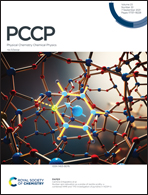Separating a linear C5 hydrocarbon from a branched C6 hydrocarbon: n-pentane from 2,2-dimethyl butane using levitation and blow torch effects†
Abstract
The separation of linear from branched hydrocarbons is often required in many situations. There are several methods through which they can be separated but none provides a very high degree of purity or works without considerable expenditure of energy. Recently, a novel method was proposed to separate a mixture of neopentane and n-pentane. The present work demonstrates that the method can be used for separating other mixtures of hydrocarbons as well, by attempting the separation of a mixture of 2,2-dimethyl butane and n-pentane. Intermolecular interaction potentials have been modified to reproduce the experimental heat of adsorption and diffusivity of 2,2-dimethyl butane and n-pentane in zeolite NaY. The method involves choosing the correct host zeolite or other porous solids and introducing hot zones at appropriate positions. This result drives both the components to the opposite ends of the zeolite column, thus leading to separation. The achieved separation factors are much higher than what can be obtained with the help of existing methods. Different properties have been computed to understand the process involved in the separation of the mixture. The approach employed here uses very little energy for separation, making it suitable for green chemistry.



 Please wait while we load your content...
Please wait while we load your content...